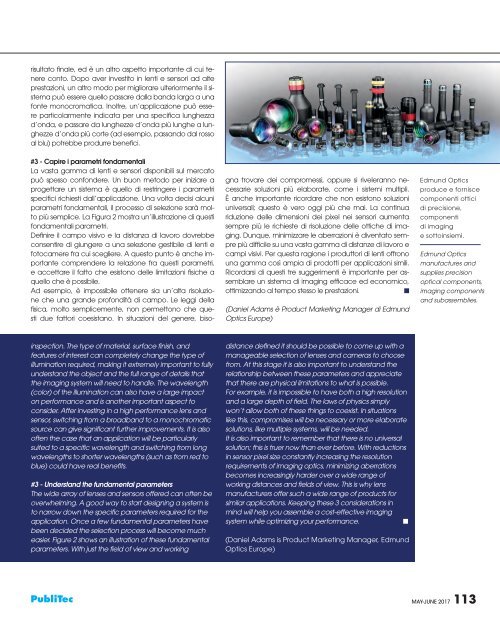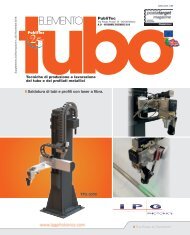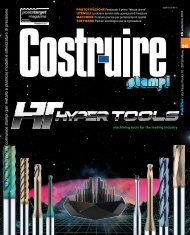AsseMec120_MAGGIU_2017
Create successful ePaper yourself
Turn your PDF publications into a flip-book with our unique Google optimized e-Paper software.
isultato finale, ed è un altro aspetto importante di cui tenere<br />
conto. Dopo aver investito in lenti e sensori ad alte<br />
prestazioni, un altro modo per migliorare ulteriormente il sistema<br />
può essere quello passare dalla banda larga a una<br />
fonte monocromatica. Inoltre, un’applicazione può essere<br />
particolarmente indicata per una specifica lunghezza<br />
d’onda, e passare da lunghezze d’onda più lunghe a lunghezze<br />
d’onda più corte (ad esempio, passando dal rosso<br />
al blu) potrebbe produrre benefici.<br />
#3 - Capire i parametri fondamentali<br />
La vasta gamma di lenti e sensori disponibili sul mercato<br />
può spesso confondere. Un buon metodo per iniziare a<br />
progettare un sistema è quello di restringere i parametri<br />
specifici richiesti dall’applicazione. Una volta decisi alcuni<br />
parametri fondamentali, il processo di selezione sarà molto<br />
più semplice. La Figura 2 mostra un’illustrazione di questi<br />
fondamentali parametri.<br />
Definire il campo visivo e la distanza di lavoro dovrebbe<br />
consentire di giungere a una selezione gestibile di lenti e<br />
fotocamere fra cui scegliere. A questo punto è anche importante<br />
comprendere la relazione fra questi parametri,<br />
e accettare il fatto che esistono delle limitazioni fisiche a<br />
quello che è possibile.<br />
Ad esempio, è impossibile ottenere sia un’alta risoluzione<br />
che una grande profondità di campo. Le leggi della<br />
fisica, molto semplicemente, non permettono che questi<br />
due fattori coesistano. In situazioni del genere, bisogna<br />
trovare dei compromessi, oppure si riveleranno necessarie<br />
soluzioni più elaborate, come i sistemi multipli.<br />
È anche importante ricordare che non esistono soluzioni<br />
universali; questo è vero oggi più che mai. La continua<br />
riduzione delle dimensioni dei pixel nei sensori aumenta<br />
sempre più le richieste di risoluzione delle ottiche di imaging.<br />
Dunque, minimizzare le aberrazioni è diventato sempre<br />
più difficile su una vasta gamma di distanze di lavoro e<br />
campi visivi. Per questa ragione i produttori di lenti offrono<br />
una gamma così ampia di prodotti per applicazioni simili.<br />
Ricordarsi di questi tre suggerimenti è importante per assemblare<br />
un sistema di imaging efficace ed economico,<br />
ottimizzando al tempo stesso le prestazioni.<br />
n<br />
(Daniel Adams è Product Marketing Manager di Edmund<br />
Optics Europe)<br />
Edmund Optics<br />
produce e fornisce<br />
componenti ottici<br />
di precisione,<br />
componenti<br />
di imaging<br />
e sottoinsiemi.<br />
Edmund Optics<br />
manufactures and<br />
supplies precision<br />
optical components,<br />
imaging components<br />
and subassemblies.<br />
inspection. The type of material, surface finish, and<br />
features of interest can completely change the type of<br />
illumination required, making it extremely important to fully<br />
understand the object and the full range of details that<br />
the imaging system will need to handle. The wavelength<br />
(color) of the illumination can also have a large impact<br />
on performance and is another important aspect to<br />
consider. After investing in a high performance lens and<br />
sensor, switching from a broadband to a monochromatic<br />
source can give significant further improvements. It is also<br />
often the case that an application will be particularly<br />
suited to a specific wavelength and switching from long<br />
wavelengths to shorter wavelengths (such as from red to<br />
blue) could have real benefits.<br />
#3 - Understand the fundamental parameters<br />
The wide array of lenses and sensors offered can often be<br />
overwhelming. A good way to start designing a system is<br />
to narrow down the specific parameters required for the<br />
application. Once a few fundamental parameters have<br />
been decided the selection process will become much<br />
easier. Figure 2 shows an illustration of these fundamental<br />
parameters. With just the field of view and working<br />
distance defined it should be possible to come up with a<br />
manageable selection of lenses and cameras to choose<br />
from. At this stage it is also important to understand the<br />
relationship between these parameters and appreciate<br />
that there are physical limitations to what is possible.<br />
For example, it is impossible to have both a high resolution<br />
and a large depth of field. The laws of physics simply<br />
won’t allow both of these things to coexist. In situations<br />
like this, compromises will be necessary or more elaborate<br />
solutions, like multiple systems, will be needed.<br />
It is also important to remember that there is no universal<br />
solution; this is truer now than ever before. With reductions<br />
in sensor pixel size constantly increasing the resolution<br />
requirements of imaging optics, minimizing aberrations<br />
becomes increasingly harder over a wide range of<br />
working distances and fields of view. This is why lens<br />
manufacturers offer such a wide range of products for<br />
similar applications. Keeping these 3 considerations in<br />
mind will help you assemble a cost-effective imaging<br />
system while optimizing your performance.<br />
n<br />
(Daniel Adams is Product Marketing Manager, Edmund<br />
Optics Europe)<br />
PubliTec MAY-JUNE <strong>2017</strong> 113





